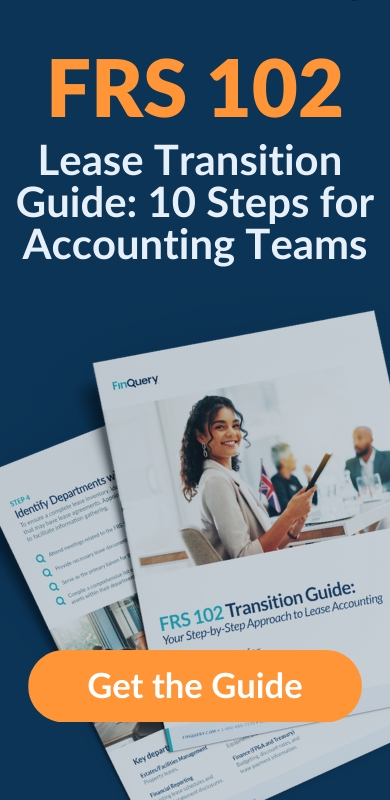In March 2024, the Financial Reporting Council (FRC) published the most significant revision to FRS 102 since its inception. The update, effective for accounting periods beginning on or after January 1, 2026, introduces a single accounting model for lease accounting that will fundamentally change how preparers, especially lessees, recognise and report leases in the UK and Republic of Ireland.
Why was FRS 102 revised?
The FRC’s objective with the 2024 amendments is to improve transparency and comparability in financial reporting. The previous lease accounting model allowed lessees to keep many leases off the balance sheet as operating leases, which limited users’ visibility into an entity’s true liabilities and asset usage.
To address this, the 2024 revisions, specifically those in Section 20, bring FRS 102 closer to IFRS 16 for lessees by introducing a single-model approach, effectively eliminating the operating lease classification for most lessee arrangements. However, there are significant differences between the FRS 102 lease amendments and the IFRS 16 lease accounting standard. In this article, we will discuss some of the transition considerations for organisations to better prepare for the conversion to Section 20 of the FRS 102 amendments.
Discount rate application
FRS 102 introduces an alternative to the incremental borrowing rate (IBR) called the obtainable borrowing rate (OBR). This is the rate of interest that a lessee would have to pay to borrow, over a similar term, an amount similar to the total undiscounted value of lease payments to be included in the measurement of the lease liability. As these inputs are more easily determined by the lessee than those of the incremental borrowing rate, organisations transitioning to FRS 102 will have an easier time in finding and calculating their discount rate to apply to the new lease liabilities, representing a significant simplification from transitioning to IFRS 16.
Additionally, FRS 102 allows lessees to make an election to apply a single discount rate to a portfolio of leases with reasonably similar characteristics. For example, leases of a similar class of underlying asset with a similar remaining lease term in a similar economic environment.
For public benefit entities, an additional simplification is provided. Some public benefit entities may not borrow, and therefore would struggle to obtain the IBR or OBR. If a public benefit entity (PBE) cannot easily determine the leases’s implicit rate, IBR, or OBR, it can use the interest rate from its bank deposits.
Transition approach
A company applying IFRS 16 was permitted to choose, as an accounting policy, between the fully-retrospective approach or a modified retrospective approach (with two measurement options). In order to simplify this further for FRS 102 adopters, FRS 102 requires a lessee to apply the modified retrospective approach and set the right-of-use asset equal to the lease liability (adjusted for any prepaid or deferred payments), unless it previously adopted IFRS 16. If so, there is an additional alternative elective expedient.
IFRS 16 balances
As a practical expedient, a lessee applying IFRS 16 may choose to use the carrying amounts of the lease liability and right-of-use asset calculated under IFRS 16 as the opening lease liability and right-of-use asset on the date of transition to FRS 102. If an organisation chooses this practical expedient, it should be applied to all its leases and that decision needs to be included in its financial disclosures.
Hindsight
An organisation applying the amendments to FRS 102 may use hindsight, for example, in determining the lease term as of the application date if the contract contains options to extend or terminate the lease. Additionally, when determining whether a contract contains a lease for FRS 102 application, organisations may assess whether a contract existing at the date of transition contains a lease using the facts and circumstances existing at the transition date to FRS 102, rather than at the commencement date of the lease.
Short-term and low value asset exemption
Per FRS 102, a short-term lease is defined as a lease that, at the commencement date, has a lease term of 12 months or less, and does not contain a purchase option. Lessees are able to exempt leases that meet the definition of ”short-term” from capitalisation under FRS 102. However, organisations may have leases that, at the initial application date to FRS 102, have 12 months of less remaining. While they would not have met the definition of a short-term lease, which again considers the term from the commencement date, FRS 102 provides an election for lessees to choose not to recognise a lease liability and right of use asset to those leases for which the term ends within 12 months of the application date to FRS 102. If an organisation chooses this expedient, they need to disclose the cost of the short-term lease expense in their FRS 102 disclosures.
Similarly, FRS 102 provides a similar expedient exemption for leases for which the underlying asset is of low value. Rather than capitalising those leases, they are accounted for as though they were short-term and similarly, their cost needs to be disclosed.
Preparing for the impact on financial statements
Entities used to off-balance-sheet treatment of leases will likely see:
- Increase in reported assets and liabilities, particularly in industries with significant lease portfolios (e.g., retail, hospitality, transport).
- Changes in key financial ratios, such as:
- Lower asset turnover (due to higher total assets)
- Higher debt-to-equity ratio
- EBITDA improvement (since lease expenses are now split into depreciation and interest)
- Front-loading of expenses under the interest-based amortisation schedule, compared to straight-line lease expense under the old model.
Stakeholders, including lenders and investors, should be informed of these changes in advance to avoid misinterpretation of the new financial metrics.
Other implementation considerations
Preparation will require more than just accounting adjustments. Key considerations include:
- Lease Inventory – Identify all existing lease contracts, including embedded leases in service arrangements.
- Systems and Processes – Upgrade accounting software or lease tracking tools capable of handling the new recognition and measurement rules.
- Training – Finance and audit teams will need training to apply the standard correctly and consistently.
- Communication – Engage with stakeholders early, especially where loan covenants or performance metrics may be affected.
For entities with many or complex leases, early transition planning is essential to avoid last-minute compliance risks.
Summary
The 2024 revision to FRS 102 marks a major shift in lease accounting for UK GAAP entities. By adopting this new model, the FRC aims to enhance financial reporting clarity and better reflect the economic reality of leasing transactions. Although the implementation deadline is January 2026, early planning is essential, particularly for entities with high lease volumes or limited system capabilities. Now is the time to take inventory, assess the potential impact, and build the infrastructure for a smooth transition.





